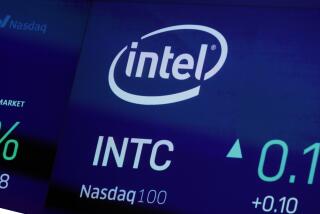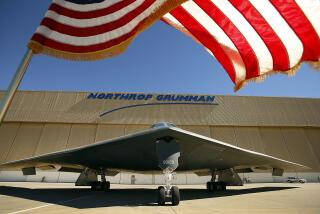AST to Close Southland Plant : Area May Lose as Many as 515 Jobs in Latest Retrenchment
- Share via
IRVINE — AST Research Inc., struggling to keep pace in the cutthroat personal computer business, said Friday that it will close its Fountain Valley manufacturing plant and lay off all 440 employees there as part of a major restructuring that will reduce its work force by 10% worldwide.
The nation’s sixth-largest computer maker, which employs 6,900, also said it expects to post a quarterly loss of up to $40 million--far worse than analysts had expected. AST stock dropped $1.50 a share Friday to close at $10.75 in heavy Nasdaq trading. The shares traded as high as $33 early this year.
AST attributed its problems to an unusual confluence of product delays, parts shortages and atypically low profit margins. But all companies in the PC industry--which in many ways is now a marketing-driven business that relies on commodity parts and suffers chronically thin margins--are wrestling with similar issues.
Analysts were not convinced that Friday’s announcement was the last of the bad news. “They don’t completely have a handle on the situation, and that is of greatest concern,” said Keven McCarthy, an analyst at NatWest Securities Corp. in New York.
AST said the notebook computer manufacturing that takes place in Fountain Valley will be transferred to the company’s Taiwan plant. In addition to the Fountain Valley workers, about 250 employees worldwide--including 50 to 75 at AST’s Irvine headquarters--will be terminated by Feb. 1.
“This is a gut-wrenching thing to have to do,” said James T. Schraith, AST’s president. “But for the sake of the remaining employees and the people who have a stake in the company, we simply had to make the necessary changes to become a stronger company.”
The layoff is AST’s second in just over a year. The company laid off 1,050 employees, including 650 in Orange County, in the aftermath of its July, 1993, purchase of Tandy Corp.’s computer manufacturing operations. Since then it has shifted some of its Fountain Valley operations to the former Tandy plant in Ft. Worth.
In terms of percentages, AST’s latest job cuts are “not a lot,” said Anil Puri, chair of the economics department at California State University, Fullerton. “But AST is an important company, a local, home-grown company, and when they make a decision like that, we need to pay attention.”
The company’s decision to close the plant is part of the continuing loss of high-technology jobs from Southern California, Puri said. In August, Hughes Aircraft Co. said it would relocate most of its Fullerton operations, laying off 1,000 workers. Last month, Northrop Grumman Corp., a Los Angeles aerospace company, said it would lay off 8,650 workers, including 4,150 in Southern California.
Schraith said AST has no plans to move its Irvine headquarters, which has a staff of 800.
Analysts attributed AST’s problems to an oversupply of older products and an inability to get new models out the door quickly. In the PC business, products can become obsolete in a matter of months, and companies are under constant pressure to bring out new products with more features for less money--and accurately predict how many they will sell, so they neither get stuck with excess inventory nor lose business because they can’t meet orders.
Over the last several years, most PC companies--including IBM, Compaq and Dell--have at one time or another botched this delicate balancing act and suffered the financial consequences.
But AST has had more than its share of volatility, and its current problems come at a time when the PC market, driven by strong sales of fully featured “multimedia” PCs to consumers, is booming.
At the end of August, AST said it would report a loss for its first fiscal quarter, but Friday’s announcement of red ink totaling $39 million to $40 million was as much as three times what had been predicted by analysts.
Quarterly sales will also be much lower than anticipated. AST said revenue will probably be $495 million, down from $514 million for the comparable period last year and well below analysts’ predictions of $515 million or more. Final financial results will be released Oct. 27.
As recently as early August, AST executives were painting a rosy picture for Wall Street. But less than 30 days later, the company said the profit it had projected would instead be a loss and that it was taking steps to rectify the situation.
From then on, Schraith said, senior executives were researching the company’s options, and they settled about 10 days ago on the cost-cutting action announced Friday.
“The closing of the factory was expected,” said Stephen Dube, an analyst at Wasserstein Perella Securities in New York. “The surprise was the manpower cuts outside of Fountain Valley. We won’t find out at least until the March quarter if AST is back in the game.”
Employees have suspected for some time that last November’s layoffs weren’t the last of the bad news. Speculation surged Thursday when executives told employees to report for plant-wide meetings Friday morning.
“I slept OK last night, but it was tough waiting for the 6 a.m. meeting,” said stockroom worker Jose Corvarruvias, 33. “They started the meeting by saying, ‘Good morning,’ but we told them it sounded like a bad morning.”
*
Contributing to this report were Times staff writers John O’Dell, Greg Johnson and Debora Vrana and correspondents Hope Hamashige and Debra Cano.
AST Research at a Glance
AST Research emerged from the pack of personal computer “clone” vendors in the late 1980’s, and is now the nation’s sixth-largest PC company. But the firm has had trouble maintaining consistent performance in a highly volatile market.
* Headquarters: Irvine * Chief Executive: Safi U. Qureshey * Employees: 6,900 * Major products: IBM compatible personal computers, notebooks and network server systems. * 1994 revenue (Year ended June 30): 2.4 billion * 1994 profit (Year ended June 30): 53.5 million
STOCK PRICE:
Friday: $10.75
Sources: Bloomberg Business News; DataTimes
Researched by ADAM S. BAUMAN / Los Angeles Times
More to Read
Inside the business of entertainment
The Wide Shot brings you news, analysis and insights on everything from streaming wars to production — and what it all means for the future.
You may occasionally receive promotional content from the Los Angeles Times.










